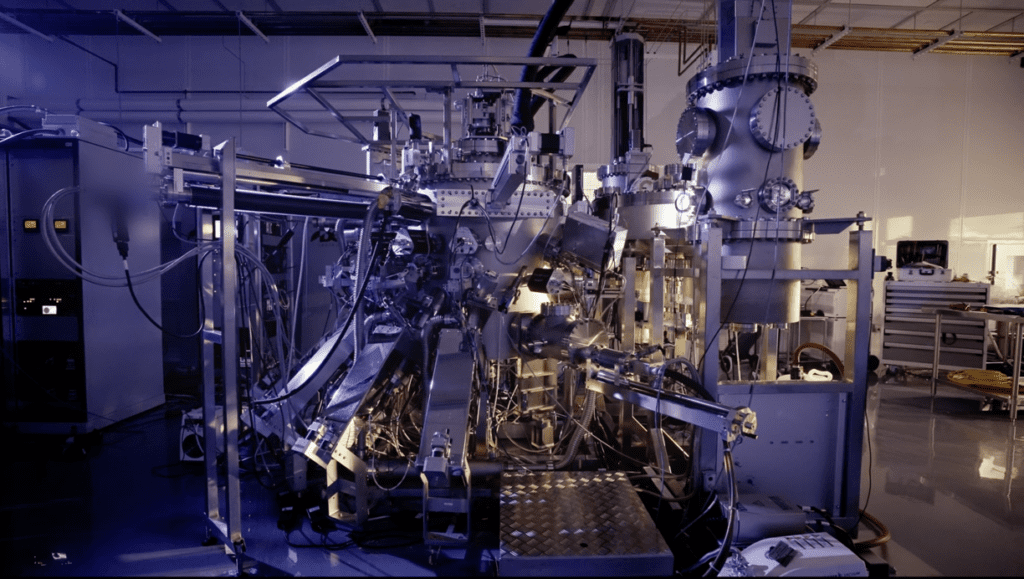Artificial Intelligence
Cyber
Future Telecoms
Materials
Net zero
Quantum
Robotics
Wise words and waggishness… January 2026
Reading time: 13 mins
The first commercial quantum computer is years, not decades, away and photonics will have a big role to play in making this happen.
“We humans get obsessed with how nascent technologies work, and then once we’ve had them for a while, we don’t worry about it,” says Professor Jeremy O’Brien, co-founder and CEO of PsiQuantum, a Silicon Valley-based quantum photonics company that was born out of the University of Bristol and Imperial College London. “Do you know how a transistor works? Do you know how many are in your smartphone? There are billions of transistors in there. And how complicated do you think a system with billions of components is? I think these are the wrong questions to ask. ‘What will it do for me?’ ‘When’s it going to happen?’ Those are the questions.”

That’s good advice because when it comes to trying to understand the multitude of quantum computing technologies, it’s so easy to fall down a rabbit hole. So, just what do we need to know? Firstly, quantum qubits don’t play by the same rules as bytes. Secondly, “entanglement” is key to quantum computing power, as it makes qubits exponentially more powerful than standard bits, specifically when trying to solve complex, algorithmic problems.
If this doesn’t make sense, don’t worry, it doesn’t have to. No one really knows how entanglement works – even Einstein referred to it as “spooky action at a distance”, and descriptions haven’t improved much since. Thankfully, though, with quantum computing you don’t have to understand the science to understand the benefits. While they won’t be replacing existing technology when it comes to everyday tasks and entertainment – you’ll still be gaming on a bit-based PC – they will be able to tackle incredibly complex computations, such as mimicking chemical processes, which are currently impossible using today’s machines.

Speed is, of course, a key element here and this is where photonics comes in – the ability to use light to carry instructions, as opposed to electrical pulses. Photonics has opened a door to new possibilities within quantum, and as Dr Stephanie Simmons, co-chair of the Advisory Council on Canada’s National Quantum Strategy, and founder of Photonic Inc explains, it’s exactly the sort of development that can accelerate progress and trigger new inventions.
“We have a unique opportunity,” explains Simmons, “because we can forecast the next commercialisation of a branch of physics. And every single time we commercialise a branch of physics, it takes a while for it to play out. The last time we commercialised a branch of physics, it was semiconductors. And people got very excited about hearing aids. They weren’t thinking of AI back then.”
Unsurprisingly, quantum computing research and development is not going in a straight line. USB and FireWire. VHS and Betamax. CD and MiniDisc. When it comes to ways of sharing and distributing data, rivalries often emerge. And in the case of quantum computing, this has come down to a battle between light and matter. Photon versus electron.
‘No one really knows how entanglement works – even Einstein referred to it as ‘spooky action at a distance’’
When it comes to matter-based quantum computing, there are different types of qubits being developed by a host of major tech companies. Google and IBM are investing in superconducting qubits. Quantinuum, IonQ, and Oxford Ionics are developing trapped ion qubits. Intel and Quantum Motion are working on spin qubits. And Atom Computing and Pasqal are using single atoms to act as qubits. Comparatively, the list of major companies building a quantum computer based on light-based qubits comes down to three major players: PsiQuantum, Xanadu, and Orca Computing.
As things stand, there’s no definitive winner. But investors are starting to place their bets, with McKinsey reporting that $2.35bn was invested in quantum technology start-ups during 2022. And recent announcements – such as Microsoft’s investment in Photonics Inc and Series D funding of $450m for PsiQuantum – suggest that the focus may be shifting toward photonics.

“We can argue all day about which technology is the best,” explains PsiQuantum’s Chief Scientific Officer and Co-Founder, Dr Pete Shadbolt. “But I will satisfy the natural inquisitiveness around photonics. Photons don’t feel heat. They don’t get jiggled around by heat. So we just have an intrinsic advantage. That’s why a lot of the early demonstrations of quantum information were done using photons. Light is pretty well isolated from its environment.”
A further benefit to using a photon-based approach to quantum computing is the ability to tap into existing technologies and infrastructures, compared to matter-based qubits.
“The other advantage is manufacturability,” says Shadbolt. “Because we can use these existing semiconductor manufacturing processes to make the chips that manipulate the photons. And we can do that without the profound reinvention of semiconductor manufacturing.”
PsiQuantum was founded in 2016 by a number of UK-based academics, who came to the company via the University of Bristol’s Centre for Quantum Photonics and Imperial College London. PsiQuantum – now based in Palo Alto, with more than 250 employees and a $3bn valuation – follows the trend of most quantum companies, which grew from university research groups.

“All quantum computing efforts come out of university research groups,” Shadbolt says. “All of the efforts inside Google, IBM, etc. It’s always an academic research group to begin with. It’s a professor of experimental physics who’s gotten into quantum computing. They had some wacky hardware in a physics lab. They published a load of papers and they got to like three qubits or something. Then, at some point, they said, ‘Okay, let’s scale up,? Let’s go and build a useful machine.’ And so that’s where all of these corporate or commercial efforts came from.”
The idea of a “useful” quantum computer sits at the heart of PsiQuantum. For a period there was an optimistic view that developing a 100 qubits machine could result in a commercially useful quantum computer (Google made headlines for achieving ‘quantum supremacy’ in 2019, creating quantum states on 53 qubits). But this didn’t factor in the need for error correction. And PsiQuantum realised from its inception that it would need far more than just 100 qubits.
“After careful thinking and a bit of informed judgement, we said, ‘You’ve got to do a big one!’”
Dr Pete Shadbolt, PsiQuantum Chief Scientific Officer and Co-Founder
“The trouble is that whilst there was some hope that you might be able to do something useful with about 100 qubits, that was always a fairly speculative hope,” Shadbolt explains. “That was always in contrast with the real academic consensus, which was that you probably actually need about a million qubits to do anything useful. And there’s a yawning gap between 100 and one million qubits, which comes from the need for error correction. Quantum computers have a lot more errors than conventional computers, because you’re working with wacky quantum physics, and because they’re so sensitive to their environment. They just have more errors.”
So, whilst Google and other companies continue working with qubits in the 100 range (Google currently sits at 72), PsiQuantum launched with a “moonshot” vision of achieving one million qubits, which it believes is necessary to build the world’s first utility-scale, fault-tolerant system.
“After careful thinking and a bit of informed judgement, we said, ‘You’ve got to do a big one!’” explains Shadbolt. “And so PsiQuantum was founded on a very contrarian, very investor-unfriendly position, which is that there is no minimum viable product. There is no shortcut. You have to build a giant machine. You can’t scale out from something small. You have to start with the entire thing.”
This approach has set PsiQuantum apart, and Shadbolt admits that “we disqualified ourselves with investors that couldn’t stomach the real thing”. However, by having a clear vision for how it would achieve a useful quantum computer – by partnering with existing “tier 1” semiconductor fabrication plants (fabs) – PsiQuantum attracted significant investment, from the right sources.
“It’s unsatisfying in a sense, but it’s real derisking, as opposed to endlessly launching toy rockets. That might be very satisfying. They go up; they come back down. But you didn’t solve anything. And so PsiQuantum was just set up with a very contrarian, differentiated kind of ideology. Not just doing incremental development. But by investing in the real problems that appear at scale.”
Having addressed the need to manufacture a quantum computer at scale, the PsiQuantum team quickly realised that it needed to leave the UK to get the best access to funds and expertise.
“Building a quantum computer was more of a semiconductor manufacturing problem than a quantum physics or research problem,” Shadbolt says. “And so when we started the company, we took advice from a broad range of people in the UK and elsewhere, and it was just really clear that Silicon Valley was the best location.”
Despite moving the company to the USA, PsiQuantum recently announced the opening of the PsiDaresbury in the UK, backed by £9m of government funding, which will give PsiQuantum access to one of Europe’s largest liquid-helium cryogenic plants. This will enable the company to develop its single-photon detectors, which run at temperatures a few degrees above absolute zero. And with a superconductor partnership already in place, it hopes to start manufacturing soon.
“This year, we should start to actually have these big cabinets,” says Shadbolt. “They look a little bit like the 19-inch racks that you’d find in a data centre. So that’s a big milestone for this year; to have those cabinets actually up and running at scale. We’ve already got a mini one running in the UK.”
“We’re really talking about just a completely new paradigm in terms of how we approach solutions”
Krysta Svore, VP of Advanced Quantum Development, Microsoft.
When operational, quantum computers will look more like data centres than conventional computers. And they will require networking technology that supports the transfer of quantum data, which is another core benefit of photonics technology, given that it was traditionally explored as a way of increasing the speed and efficiency of networks.
“You’re not going to fit a million qubits in one box. They’re going to need a number of boxes. And you’ve got to get qubits between boxes,” says Shadbolt. “You can’t just use Ethernet, right? You need some kind of quantum interconnect with photons. And we’re very lucky that we can just send the photons straight over optical fibre. That’s really difficult for the other guys. Like for IBM, for instance, it’s pretty tough to network their boxes together.”
Photonic Inc is one of the companies that identified the issue of networking at the outset, and is attempting to build a quantum solution that combines the best of both light and matter, by building the first “scalable, fault-tolerant quantum computing and networking platform, based on photonically linked silicon spin qubits.
“How do we get large scale, distributed quantum information processing working, and coordinate all of these different computers together over a network? That is a core challenge,” continues Dr Simmons, founder of Photonic Inc. “And the word ‘network’ is almost a little bit different for quantum. It’s almost a completely different overlay network that really thinks about what you can do when you have entanglement in different locations. The ability to take entanglement, which is like a special quantum resource, and distribute that and use that as a resource. That underpins so much of the quantum technologies that we all want to build. Kind of like how we think about electricity.”

Having identified the importance of backing the right quantum technology, especially from a networking perspective, Microsoft recently invested in Photonics Inc. as part of a broader partnership. (Microsoft is already working with the likes of IonQ, Pascal, Quantinuum, and QCI to provide access to quantum machines via Azure Quantum.)
“Microsoft announced a strategic co-innovation collaboration with Photonic Inc. to advance the quantum ecosystem with the next stages in quantum networking,” explains Krysta Svore, Vice President of Advanced Quantum Development at Microsoft. “Ultimately, we want to be able to connect and scale quantum supercomputers, create networks of quantum sensors, and enable new types of applications.”
There are still huge challenges for start-ups working in the field of quantum computing. As of today, no company has developed a useful quantum computer. The prototypes available right now are immature, and whilst small-scale demonstrations may be impressive, they are still firmly grounded in the “Foundational” category of Microsoft’s three levels for quantum computing implementation. However, there is a huge amount of optimism around what can be achieved in the next 12-24 months.
“We’re very lucky that we can just send the photons straight over optical fibre. That’s really difficult for the other guys.”
Dr Pete Shadbolt, PsiQuantum Chief Scientific Officer and Co-Founder
Start-up backing has reflected this optimism, with McKinsey reporting that investment in quantum technology start-ups increased from around $100m in 2015 to almost $2.35bn in 2022. And in countries like the UK, Canada, and the US – which have a strong tradition of state support for quantum development – governments are continuing to invest heavily, too (with £2.5bn of quantum funding announced in the UK’s 2023 Spring Budget).
Photonics will play an integral part in the continued development of quantum technology, but its myriad of use cases and requirements – the majority of which we’re not even aware of yet – will require a new level of collaboration. So maybe it won’t be a matter of winner-takes-all.
“We’re really talking about just a completely new paradigm in terms of how we approach solutions,” says Svore. “And as we think about new paradigms, we also really need a global ecosystem. It’s not going to just be any one company, any one individual that’s going to get us to the quantum internet, to our path to quantum-at-scale. It will take a global ecosystem.”

Dan Oliver is a UK-based technology and design journalist with 25 years of experience. Dan has produced content for numerous brands and publications including The Sunday Times, TechRadar, Wallpaper* magazine, Amazon, Microsoft, Meta, and more.
Quantum
Reading time: 10 mins
Quantum
Reading time: 10 mins
Quantum
Reading time: 11 mins
Robotics
Reading time: 1 mins
Quantum
Reading time: 3 mins